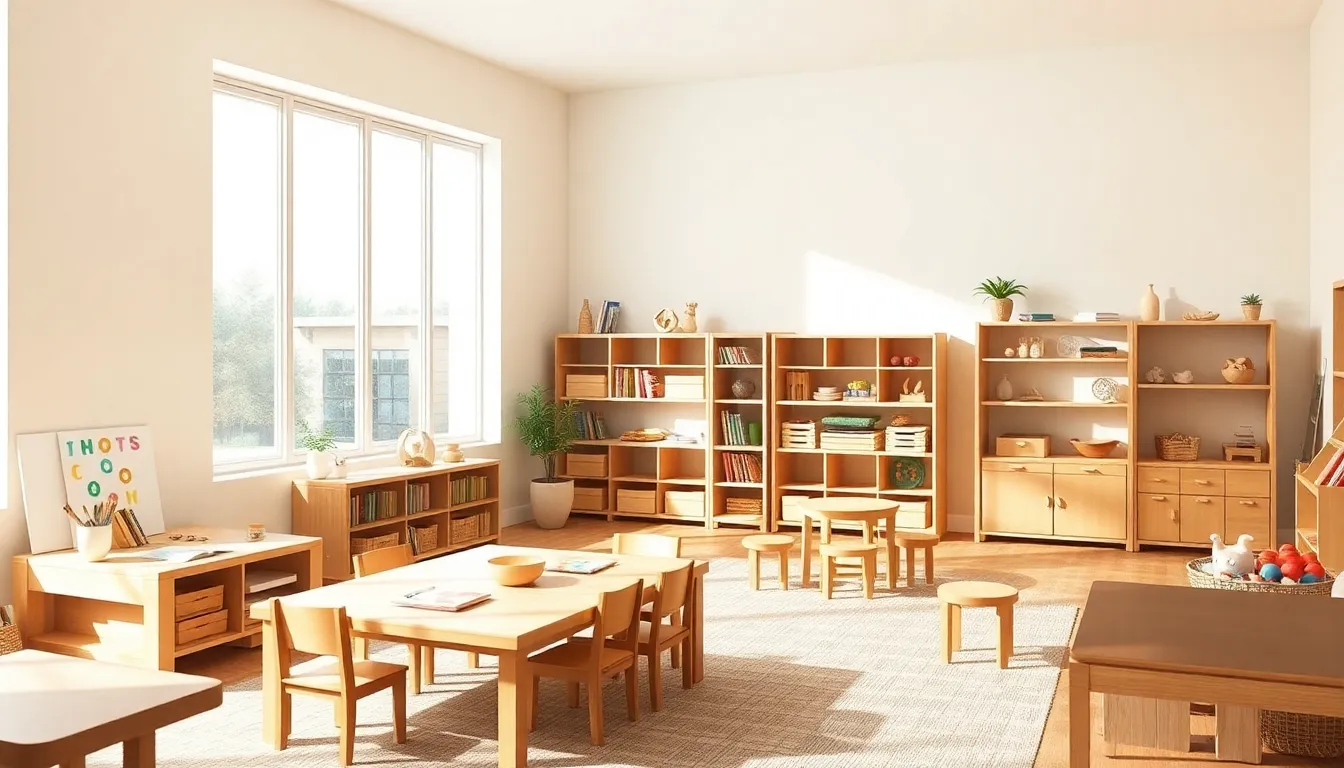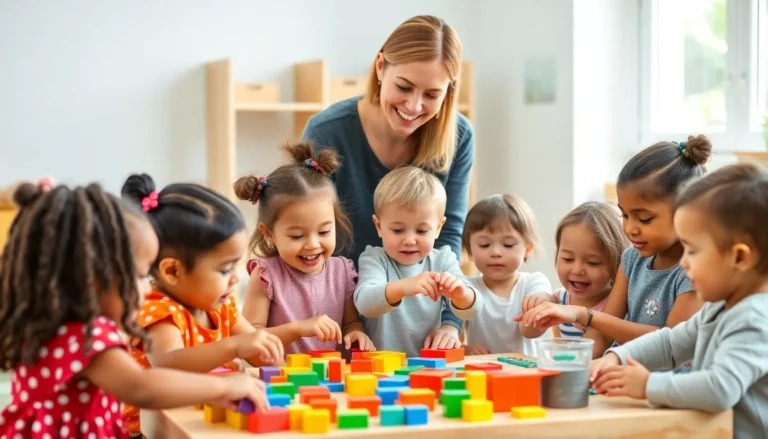Table of Contents
ToggleCreating a Montessori space is all about fostering independence and encouraging exploration. This unique approach to education emphasizes hands-on learning and child-led activities, making the environment a crucial element in a child’s development. A well-organized space not only supports learning but also instills a sense of responsibility and ownership in children.
In a Montessori setup, every item has its place and purpose. From thoughtfully arranged materials to child-sized furniture, each element plays a role in promoting autonomy. Understanding how to design this space can transform a home or classroom into a vibrant learning hub, where children thrive and curiosity flourishes. By focusing on intentional organization and accessibility, caregivers can create an environment that inspires children to engage, discover, and grow.
Importance Of Montessori Space Setup
Montessori space setup promotes independence and exploration, which are crucial for a child’s development. A well-organized environment supports hands-on learning and encourages child-led activities. Each item in a Montessori setup serves a specific purpose, highlighting the importance of intentional organization.
Child-sized furniture enhances accessibility, allowing children to navigate their environment confidently. Such arrangements empower children to make choices, fostering a sense of responsibility and ownership. Well-defined areas for various activities, like practical life skills, art, and sensory play, create opportunities for focused engagement.
A thoughtfully designed space reduces distractions and facilitates concentration, enhancing learning experiences. Natural light and calming colors contribute to a serene atmosphere, which positively impacts behavior and mood. In a Montessori space, children gain the freedom to explore, discover, and develop critical thinking skills through interaction with their surroundings.
Key Elements Of Montessori Space Setup

Montessori space setup involves various key elements that enhance learning and foster independence. Each aspect plays a crucial role in creating an environment conducive to exploration and growth.
Functional Areas
Functional areas enable children to engage in different activities simultaneously. Clear zones include:
- Practical Life Skills: This area features materials for everyday tasks, promoting responsibility and self-sufficiency. Children practice skills like pouring, sorting, and buttoning.
- Art and Creativity: Art supplies are organized for easy access, encouraging self-expression through various mediums like painting, drawing, and crafting.
- Sensorial Play: This zone includes tactile materials that stimulate the senses, helping children refine their perceptions and develop cognitive skills.
- Reading Nook: Cozy spaces with age-appropriate books invite children to read independently, fostering literacy and a love for learning.
- Science Exploration: Hands-on materials for experiments and observations encourage inquiry and a deep understanding of natural phenomena.
Accessibility
Accessibility is vital for empowering children within their environment. Considerations include:
- Child-Sized Furniture: Tables and chairs designed for children’s height enhance comfort and independence during activities.
- Movement-Friendly Layout: Open pathways and strategically placed materials allow children to navigate freely, encouraging exploration without barriers.
- Low Shelving Units: Shelves within reach help children select and return materials independently, fostering a sense of ownership over their space.
- Adaptable Spaces: Flexible furniture arrangement supports various learning activities and group sizes, accommodating different interactions.
Aesthetic Considerations
Aesthetics play a significant role in creating a serene and inviting atmosphere. Key elements include:
- Natural Light: Maximizing sunlight through windows promotes positivity and reduces stress, contributing to a calm environment.
- Calming Color Palette: Soft, neutral colors create a tranquil backdrop that minimizes distractions and enhances focus.
- Natural Materials: Wood, cotton, and other natural materials encourage a connection to the environment and support sensory development.
- Thoughtful Organization: An orderly, clutter-free space inspires confidence and clarity, allowing children to concentrate better on activities.
Creating A Montessori Space At Home
A well-organized Montessori space at home fosters independence and exploration in children. Intentional setup promotes hands-on learning and supports child-led activities.
Tips For Parents
- Incorporate Low Shelves: Low shelving units allow easy access to materials, enabling children to choose activities independently.
- Use Child-Sized Furniture: Opt for tables and chairs that accommodate children’s height, promoting comfort and accessibility.
- Create Defined Areas: Establish specific zones for various activities, such as art, practical life, and reading, to enhance focus and organization.
- Encourage Natural Light: Maximize daylight with natural window coverings to create a warm, inviting environment.
- Limit Distractions: Maintain a minimalist approach by reducing clutter to support concentration and engagement.
Age-Appropriate Materials
- Practical Life Tools: Include child-sized kitchen utensils, gardening tools, and cleaning supplies to foster daily skills.
- Art Supplies: Provide a variety of materials, such as non-toxic paints, crayons, and quality paper to encourage creativity.
- Sensorial Materials: Use items that engage the senses, like textured blocks, sound jars, and color matching games for exploration.
- Books and Reading Materials: Stock age-appropriate books that reflect children’s interests to promote literacy and a love of reading.
- Science Exploration Kits: Introduce simple science experiments, nature observation tools, and magnifying glasses to inspire curiosity.
Common Mistakes To Avoid
Creating a Montessori space can enhance children’s learning, but several common mistakes can undermine its effectiveness.
- Neglecting Accessibility: Failing to provide child-sized furniture and low shelves limits children’s independence. Ensure all materials are within reach for easy access.
- Overcrowding: Overstuffing the space with too many materials leads to distractions. Select only essential items that promote engagement and interaction.
- Ignoring Purposeful Organization: Lack of intentional organization can confuse children. Arrange materials logically and consistently, allowing children to understand where things belong.
- Forgetting Aesthetic Elements: Dismissing the impact of aesthetics can detract from the learning environment. Use calming colors and natural materials to create a serene atmosphere.
- Disregarding Defined Areas: Randomly placing materials without designated zones reduces focus. Establish specific areas for different activities to facilitate structured engagement.
- Using Age-Inappropriate Materials: Offering materials that aren’t suited for children’s developmental stages hampers learning. Choose age-appropriate tools and resources that foster skill development.
- Limiting Natural Light: Blocking natural light can negatively affect mood and focus. Prioritize windows and open spaces to promote a bright, inviting setting.
- Overlooking Sensory Experiences: Ignoring the importance of sensory materials can hinder exploration. Incorporate diverse textures, sounds, and visuals to enrich learning experiences.
Avoiding these common pitfalls contributes to an effective and nurturing Montessori environment, allowing children to thrive and engage in meaningful learning activities.
Creating a Montessori space is a transformative journey that empowers children to learn and grow independently. By focusing on intentional organization and accessibility, parents can cultivate an environment that nurtures curiosity and exploration. Thoughtfully designed areas for various activities not only enhance engagement but also foster a sense of responsibility and ownership in children.
Incorporating natural elements and maintaining a serene atmosphere further enriches the learning experience. By avoiding common pitfalls and prioritizing the needs of children, parents can establish a Montessori space that truly inspires and supports their child’s development. This dedicated approach lays the foundation for lifelong learning and critical thinking skills.





